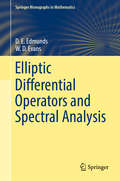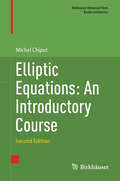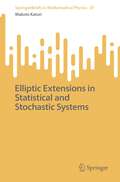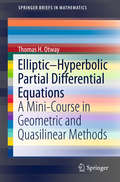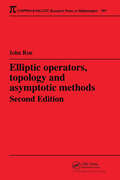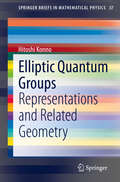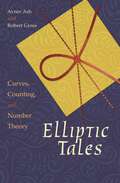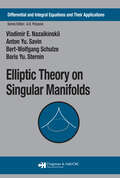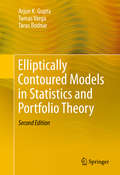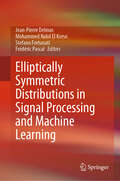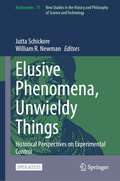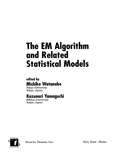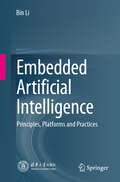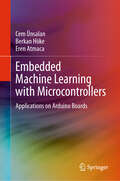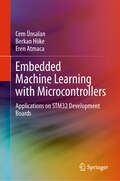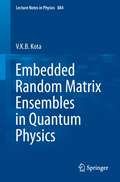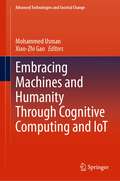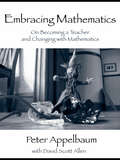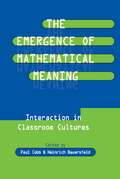- Table View
- List View
Elliptic Differential Operators and Spectral Analysis (Springer Monographs in Mathematics)
by D. E. Edmunds W. D. EvansThis book deals with elliptic differential equations, providing the analytic background necessary for the treatment of associated spectral questions, and covering important topics previously scattered throughout the literature.Starting with the basics of elliptic operators and their naturally associated function spaces, the authors then proceed to cover various related topics of current and continuing importance. Particular attention is given to the characterisation of self-adjoint extensions of symmetric operators acting in a Hilbert space and, for elliptic operators, the realisation of such extensions in terms of boundary conditions. A good deal of material not previously available in book form, such as the treatment of the Schauder estimates, is included. Requiring only basic knowledge of measure theory and functional analysis, the book is accessible to graduate students and will be of interest to all researchers in partial differential equations. The reader will value its self-contained, thorough and unified presentation of the modern theory of elliptic operators.
Elliptic Equations: An Introductory Course (Birkhäuser Advanced Texts Basler Lehrbücher)
by Michel ChipotThe aim of this book is to introduce the reader to different topics of the theory of elliptic partial differential equations by avoiding technicalities and complicated refinements. Apart from the basic theory of equations in divergence form, it includes subjects as singular perturbations, homogenization, computations, asymptotic behavior of problems in cylinders, elliptic systems, nonlinear problems, regularity theory, Navier-Stokes systems, p-Laplace type operators, large solutions, and mountain pass techniques. Just a minimum on Sobolev spaces has been introduced and work on integration on the boundary has been carefully avoided to keep the reader attention focused on the beauty and variety of these issues. The chapters are relatively independent of each other and can be read or taught separately. Numerous results presented here are original, and have not been published elsewhere. The book will be of interest to graduate students and researchers specializing in partial differential equations.
Elliptic Extensions in Statistical and Stochastic Systems (SpringerBriefs in Mathematical Physics #47)
by Makoto KatoriHermite's theorem makes it known that there are three levels of mathematical frames in which a simple addition formula is valid. They are rational, q-analogue, and elliptic-analogue. Based on the addition formula and associated mathematical structures, productive studies have been carried out in the process of q-extension of the rational (classical) formulas in enumerative combinatorics, theory of special functions, representation theory, study of integrable systems, and so on. Originating from the paper by Date, Jimbo, Kuniba, Miwa, and Okado on the exactly solvable statistical mechanics models using the theta function identities (1987), the formulas obtained at the q-level are now extended to the elliptic level in many research fields in mathematics and theoretical physics. In the present monograph, the recent progress of the elliptic extensions in the study of statistical and stochastic models in equilibrium and nonequilibrium statistical mechanics and probability theory is shown. At the elliptic level, many special functions are used, including Jacobi's theta functions, Weierstrass elliptic functions, Jacobi's elliptic functions, and others. This monograph is not intended to be a handbook of mathematical formulas of these elliptic functions, however. Thus, use is made only of the theta function of a complex-valued argument and a real-valued nome, which is a simplified version of the four kinds of Jacobi's theta functions. Then, the seven systems of orthogonal theta functions, written using a polynomial of the argument multiplied by a single theta function, or pairs of such functions, can be defined. They were introduced by Rosengren and Schlosser (2006), in association with the seven irreducible reduced affine root systems. Using Rosengren and Schlosser's theta functions, non-colliding Brownian bridges on a one-dimensional torus and an interval are discussed, along with determinantal point processes on a two-dimensional torus. Their scaling limits are argued, and the infinite particle systems are derived. Such limit transitions will be regarded as the mathematical realizations of the thermodynamic or hydrodynamic limits that are central subjects of statistical mechanics.
Elliptic Functions
by J. V. Armitage the late W. F. EberleinIn its first six chapters this 2006 text seeks to present the basic ideas and properties of the Jacobi elliptic functions as an historical essay, an attempt to answer the fascinating question: 'what would the treatment of elliptic functions have been like if Abel had developed the ideas, rather than Jacobi?' Accordingly, it is based on the idea of inverting integrals which arise in the theory of differential equations and, in particular, the differential equation that describes the motion of a simple pendulum. The later chapters present a more conventional approach to the Weierstrass functions and to elliptic integrals, and then the reader is introduced to the richly varied applications of the elliptic and related functions. Applications spanning arithmetic (solution of the general quintic, the functional equation of the Riemann zeta function), dynamics (orbits, Euler's equations, Green's functions), and also probability and statistics, are discussed.
Elliptic-Hyperbolic Partial Differential Equations
by Thomas H. OtwayThis text is a concise introduction to the partial differential equations which change from elliptic to hyperbolic type across a smooth hypersurface of their domain. These are becoming increasingly important in diverse sub-fields of both applied mathematics and engineering, for example: * The heating of fusion plasmas by electromagnetic waves * The behaviour of light near a caustic * Extremal surfaces in the space of special relativity * The formation of rapids; transonic and multiphase fluid flow * The dynamics of certain models for elastic structures * The shape of industrial surfaces such as windshields and airfoils * Pathologies of traffic flow * Harmonic fields in extended projective space They also arise in models for the early universe, for cosmic acceleration, and for possible violation of causality in the interiors of certain compact stars. Within the past 25 years, they have become central to the isometric embedding of Riemannian manifolds and the prescription of Gauss curvature for surfaces: topics in pure mathematics which themselves have important applications. Elliptic−Hyperbolic Partial Differential Equations is derived from a mini-course given at the ICMS Workshop on Differential Geometry and Continuum Mechanics held in Edinburgh, Scotland in June 2013. The focus on geometry in that meeting is reflected in these notes, along with the focus on quasilinear equations. In the spirit of the ICMS workshop, this course is addressed both to applied mathematicians and to mathematically-oriented engineers. The emphasis is on very recent applications and methods, the majority of which have not previously appeared in book form.
Elliptic Operators, Topology, and Asymptotic Methods (Chapman & Hall/CRC Research Notes in Mathematics Series)
by John RoeTen years after publication of the popular first edition of this volume, the index theorem continues to stand as a central result of modern mathematics-one of the most important foci for the interaction of topology, geometry, and analysis. Retaining its concise presentation but offering streamlined analyses and expanded coverage of important exampl
Elliptic Polynomials
by J.S. Lomont John BrillhartA remarkable interplay exists between the fields of elliptic functions and orthogonal polynomials. In the first monograph to explore their connections, Elliptic Polynomials combines these two areas of study, leading to an interesting development of some basic aspects of each. It presents new material about various classes of polynomials and about t
Elliptic Quantum Groups: Representations and Related Geometry (SpringerBriefs in Mathematical Physics #37)
by Hitoshi KonnoThis is the first book on elliptic quantum groups, i.e., quantum groups associated to elliptic solutions of the Yang-Baxter equation. Based on research by the author and his collaborators, the book presents a comprehensive survey on the subject including a brief history of formulations and applications, a detailed formulation of the elliptic quantum group in the Drinfeld realization, explicit construction of both finite and infinite-dimensional representations, and a construction of the vertex operators as intertwining operators of these representations. The vertex operators are important objects in representation theory of quantum groups. In this book, they are used to derive the elliptic q-KZ equations and their elliptic hypergeometric integral solutions. In particular, the so-called elliptic weight functions appear in such solutions. The author’s recent study showed that these elliptic weight functions are identified with Okounkov’s elliptic stable envelopes for certain equivariant elliptic cohomology and play an important role to construct geometric representations of elliptic quantum groups. Okounkov’s geometric approach to quantum integrable systems is a rapidly growing topic in mathematical physics related to the Bethe ansatz, the Alday-Gaiotto-Tachikawa correspondence between 4D SUSY gauge theories and the CFT’s, and the Nekrasov-Shatashvili correspondences between quantum integrable systems and quantum cohomology. To invite the reader to such topics is one of the aims of this book.
Elliptic Systems of Phase Transition Type (Progress in Nonlinear Differential Equations and Their Applications #91)
by Nicholas D. Alikakos Giorgio Fusco Panayotis SmyrnelisThis book focuses on the vector Allen-Cahn equation, which models coexistence of three or more phases and is related to Plateau complexes – non-orientable objects with a stratified structure. The minimal solutions of the vector equation exhibit an analogous structure not present in the scalar Allen-Cahn equation, which models coexistence of two phases and is related to minimal surfaces. The 1978 De Giorgi conjecture for the scalar problem was settled in a series of papers: Ghoussoub and Gui (2d), Ambrosio and Cabré (3d), Savin (up to 8d), and del Pino, Kowalczyk and Wei (counterexample for 9d and above). This book extends, in various ways, the Caffarelli-Córdoba density estimates that played a major role in Savin's proof. It also introduces an alternative method for obtaining pointwise estimates.
Elliptic Tales: Curves, Counting, and Number Theory
by Avner Ash Robert GrossA look at one of the most exciting unsolved problems in mathematics todayElliptic Tales describes the latest developments in number theory by looking at one of the most exciting unsolved problems in contemporary mathematics—the Birch and Swinnerton-Dyer Conjecture. In this book, Avner Ash and Robert Gross guide readers through the mathematics they need to understand this captivating problem.The key to the conjecture lies in elliptic curves, which may appear simple, but arise from some very deep—and often very mystifying—mathematical ideas. Using only basic algebra and calculus while presenting numerous eye-opening examples, Ash and Gross make these ideas accessible to general readers, and, in the process, venture to the very frontiers of modern mathematics.
Elliptic Theory on Singular Manifolds (Differential and Integral Equations and Their Applications)
by Vladimir E. Nazaikinskii Anton Yu. Savin Bert-Wolfgang Schulze Boris Yu. SterninThe analysis and topology of elliptic operators on manifolds with singularities are much more complicated than in the smooth case and require completely new mathematical notions and theories. While there has recently been much progress in the field, many of these results have remained scattered in journals and preprints.Starting from an ele
Elliptically Contoured Models in Statistics and Portfolio Theory
by Tamas Varga Arjun K. Gupta Taras BodnarElliptically Contoured Models in Statistics and Portfolio Theory fully revises the first detailed introduction to the theory of matrix variate elliptically contoured distributions. There are two additional chapters, and all the original chapters of this classic text have been updated. Resources in this book will be valuable for researchers, practitioners, and graduate students in statistics and related fields of finance and engineering. Those interested in multivariate statistical analysis and its application to portfolio theory will find this text immediately useful. In multivariate statistical analysis, elliptical distributions have recently provided an alternative to the normal model. Elliptical distributions have also increased their popularity in finance because of the ability to model heavy tails usually observed in real data. Most of the work, however, is spread out in journals throughout the world and is not easily accessible to the investigators. A noteworthy function of this book is the collection of the most important results on the theory of matrix variate elliptically contoured distributions that were previously only available in the journal-based literature. The content is organized in a unified manner that can serve an a valuable introduction to the subject.
Elliptically Symmetric Distributions in Signal Processing and Machine Learning
by Jean-Pierre Delmas Mohammed Nabil El Korso Stefano Fortunati Frédéric PascalThis book constitutes a review of recent developments in the theory and practical exploitation of the elliptical model for measured data in both classical and emerging areas of signal processing. It develops techniques usable in (among other areas): graph learning, robust clustering, linear shrinkage, information geometry, subspace-based algorithm design, and semiparametric and misspecified estimation. The various contributions combine to show how the goal of inferring information from a set of acquired data, recurrent in statistical signal processing, can be achieved, even when the common practical assumption of Gaussian distribution in the data is not valid. The elliptical model propounded maintains the performance of its inference procedures even when that assumption fails. The elliptical distribution, being fully characterized by its location vector, its scatter/covariance matrix and its so-called density generator, used to describe the impulsiveness of the data, is sufficiently flexible to model heterogeneous applications. This book is of interest to any graduate students and academic researchers wishing to acquaint themselves with the latest research in an area of rising consequence. It is also of assistance to practitioners working in data analysis, wireless communications, radar, and image processing.
Elusive Phenomena, Unwieldy Things: Historical Perspectives on Experimental Control (Archimedes #71)
by Jutta Schickore William R. NewmanThis open access book provides a historical treatment of scientific control in experimentation in the longue durée. The introduction distinguishes four related strands in the history of experimental control: the development of practices to stabilize experimental conditions; the career of the comparative design; the unfolding of methodological discussions about control practices and designs; and the history of the term “control”. Each chapter brings these distinctions to bear on specific historical episodes. The focus is on experiments with complex, elusive phenomena such as perception and learning, irregular movements, and unobservable elements. Such experiments bring control issues to the fore because they are difficult to design and stabilize and often controversial. Together, the chapters show that the local context shapes what exactly is controlled, how control can be accomplished, and how controls are justified. They also show that control strategies and methodological ideas often remain stable for a long time and change only gradually. This book, as well as the volume on analysis and synthesis in experimentation by the same editors, contains contributions by an array of experts from multiple disciplines, making it suitable for historians and philosophers of science and students alike.
The EM Algorithm and Related Statistical Models (Statistics: A Series Of Textbooks And Monographs #170)
by Michiko Watanabe Kazunori YamaguchiExploring the application and formulation of the EM algorithm, The EM Algorithm and Related Statistical Models offers a valuable method for constructing statistical models when only incomplete information is available, and proposes specific estimation algorithms for solutions to incomplete data problems. The text covers current topics including statistical models with latent variables, as well as neural network models, and Markov Chain Monte Carlo methods. It describes software resources valuable for the processing of the EM algorithm with incomplete data and for general analysis of latent structure models of categorical data, and studies accelerated versions of the EM algorithm.
Embedded Artificial Intelligence: Principles, Platforms and Practices
by Bin LiThis book focuses on the emerging topic of embedded artificial intelligence and provides a systematic summary of its principles, platforms, and practices. In the section on principles, it analyzes three main approaches for implementing embedded artificial intelligence: cloud computing mode, local mode, and local-cloud collaborative mode. The book identifies five essential components for implementing embedded artificial intelligence: embedded AI accelerator chips, lightweight neural network algorithms, model compression techniques, compiler optimization techniques, and multi-level cascaded application frameworks. The platform section introduces mainstream embedded AI accelerator chips and software frameworks currently used in the industry. The practical part outlines the development process of embedded artificial intelligence and showcases real-world application examples with accompanying code. As a comprehensive guide to the emerging field of embedded artificial intelligence, the book offers rich and in-depth content, a clear and logical structure, and a balanced approach to both theoretical analysis and practical applications. It provides significant reference value and can serve as an introductory and reference guide for researchers, scholars, students, engineers, and professionals interested in studying and implementing embedded artificial intelligence.
Embedded Machine Learning with Microcontrollers: Applications on Arduino Boards
by Cem Ünsalan Berkan Höke Eren AtmacaThis textbook introduces basic and advanced embedded machine learning methods by exploring practical applications on Arduino boards. By covering traditional and neural network-based machine learning methods implemented on microcontrollers, the text is designed for use in courses on microcontrollers and embedded machine learning systems. Following the learning-by-doing approach, the book will enable students to grasp embedded machine learning concepts through real-world examples, providing them with the design and implementation skills needed for a competitive job market. By utilizing a programming environment that enables students to reach and modify microcontroller properties easily, the material allows for fast implementation of the developed system. Students are guided in implementing machine learning methods to be deployed and tested on microcontrollers throughout the book, with the theory behind the implemented methods also emphasized. Sample codes and real-world projects are available for readers and instructors. The book will also be an ideal reference for practicing engineers and electronics hobbyists.
Embedded Machine Learning with Microcontrollers: Applications on STM32 Development Boards
by Cem Ünsalan Berkan Höke Eren AtmacaThis textbook introduces basic embedded machine learning methods by exploring practical applications on STM32 development boards. Covering traditional and neural network-based machine learning methods implemented on microcontrollers, the text is designed for use in courses on microcontrollers, microprocessor systems, and embedded systems. Following the learning by doing approach, the book will enable students to grasp embedded machine learning concepts through real-world examples that will provide them with the design and implementation skills needed for a competitive job market. By utilizing a programming environment that enables students to reach and modify low-level microcontroller properties, the material allows for more control of the developed system. Students will be guided in implementing machine learning methods to be deployed and tested on microcontrollers throughout the book, with the theory behind the implemented methods also emphasized. Sample codes and course slides are available for readers and instructors, and a solutions manual is available to instructors. The book will also be an ideal reference for practicing engineers and electronics hobbyists.
Embedded Random Matrix Ensembles in Quantum Physics
by V.K.B. KotaAlthough used with increasing frequency in many branches of physics, random matrix ensembles are not always sufficiently specific to account for important features of the physical system at hand. One refinement which retains the basic stochastic approach but allows for such features consists in the use of embedded ensembles. The present text is an exhaustive introduction to and survey of this important field. Starting with an easy-to-read introduction to general random matrix theory, the text then develops the necessary concepts from the beginning, accompanying the reader to the frontiers of present-day research. With some notable exceptions, to date these ensembles have primarily been applied in nuclear spectroscopy. A characteristic example is the use of a random two-body interaction in the framework of the nuclear shell model. Yet, topics in atomic physics, mesoscopic physics, quantum information science and statistical mechanics of isolated finite quantum systems can also be addressed using these ensembles. This book addresses graduate students and researchers with an interest in applications of random matrix theory to the modeling of more complex physical systems and interactions, with applications such as statistical spectroscopy in mind.
Embracing Machines and Humanity Through Cognitive Computing and IoT (Advanced Technologies and Societal Change)
by Mohammed Usman Xiao-Zhi GaoThis book sheds light on systems that learn extensively, with purpose and naturally interact with humans. Improving operations and increasing competitive differentiation among manufacturing organizations by harnessing the power of cognitive abilities, IoT can help build and influence the flow of information—making the shop floor more cognitive through effective processing, analysis, and operational optimization. Now we are seeing the first-hand potential of cognitive computing—its ability to transform businesses, governments, and society. The real potential of the cognitive age can be realized by combining data analysis and statistical reasoning of machines with uniquely human qualities, such as self-directed goals, common sense, and moral values, improving operations and increasing competitive differentiation among manufacturing organizations. By harnessing the power of cognitive abilities, IoT can help build and influence the flow of information—making the shop floor more cognitive through effective processing, analysis, and operational optimization. Cognitive initiatives come in all shapes and sizes, from change to strategy and everything in between. What most successful projects have in common, no matter how ambitious, is they start with a clear view of what technology can do. Therefore, the first job of a cognitive scientists is to gain a firm understanding of cognitive abilities, as presented in this book.
Embracing Mathematics: On Becoming a Teacher and Changing with Mathematics
by Peter Appelbaum with David AllenThis alternative textbook for courses on teaching mathematics asks teachers and prospective teachers to reflect on their relationships with mathematics and how these relationships influence their teaching and the experiences of their students. Applicable to all levels of schooling, the book covers basic topics such as planning and assessment, classroom management, and organization of classroom experiences; it also introduces some novel approaches to teaching mathematics, such as psychoanalytic perspectives and post-modern conceptions of curriculum. Traditional methods-of-teaching issues are recast in a new discourse, provoking new ideas for making mathematics education meaningful to teachers as well as their students. Co-authored by a professor and coordinator of mathematics education programs, with illustrative contributions from practicing elementary, middle, and high school mathematics teachers, this book is a unique collaboration across all pre-college grades, making it ideal for teacher discussion groups at any level. Embracing Mathematics: integrates pedagogy and content exploration in ways that are unique in mathematics education features textboxes with reflection questions and suggested explorations that can be easily utilized as homework for a course or as discussion opportunities for teacher reading groups offers examples of teachers’ action research projects that grew out of their interactions with the main chapters in the book is not narrowly limited to mathematics education but incorporates curriculum studies – an invaluable asset that allows instructors to find more ways to engage students in self-reflexive acts of teaching Embracing Mathematics is intended as a method text for undergraduate and master’s-level mathematics education courses and more specialized graduate courses on mathematics education, and as a resource for teacher discussion groups.
Embracing Reason: Egalitarian Ideals and the Teaching of High School Mathematics (Studies in Mathematical Thinking and Learning Series)
by Daniel Chazan Sandra Callis Michael LehmanThis book tells a single story, in many voices, about a serious and sustained set of changes in mathematics teaching practice in a high school and how those efforts influenced and were influenced by a local university. It includes the writings and perspectives of high school students, high school teachers, preservice teacher candidates, doctoral students in mathematics education and other fields, mathematics teacher educators, and other education faculty. As a whole, this case study provides an opportunity to reflect on reform visions of mathematics for all students and the challenges inherent in the implementation of these visions in US schools. It challenges us to rethink boundaries between theory and practice and the relative roles of teachers and university faculty in educational endeavors.
Emeka's Gift: An African Counting Book
by Ifeoma OnyefuluAs a young African boy travels to visit his grandmother, he passes through the village market, where he sees lots of things Granny would like -- four brooms, five hats, six necklaces, seven musical instruments, and so on. Stunning photographs taken in Emeka's southern Nigerian village illustrate this heartwarming story. The pages in this book are not numbered. Other books by this author are available in this library.
The Emergence of Mathematical Meaning: interaction in Classroom Cultures (Studies in Mathematical Thinking and Learning Series)
by Paul Cobb Heinrich BauersfeldThis book grew out of a five-year collaboration between groups of American and German mathematics educators. The central issue addressed accounting for the messiness and complexity of mathematics learning and teaching as it occurs in classroom situations. The individual chapters are based on the view that psychological and sociological perspectives each tell half of a good story. To unify these concepts requires a combined approach that takes individual students' mathematical activity seriously while simultaneously seeing their activity as necessarily socially situated. Throughout their collaboration, the chapter authors shared a single set of video recordings and transcripts made in an American elementary classroom where instruction was generally compatible with recent reform recommendations. As a consequence, the book is much more than a compendium of loosely related papers. The combined approach taken by the authors draws on interactionism and ethnomethodology. Thus, it constitutes an alternative to Vygotskian and Soviet activity theory approaches. The specific topics discussed in individual chapters include small group collaboration and learning, the teacher's practice and growth, and language, discourse, and argumentation in the mathematics classroom. This collaborative effort is valuable to educators and psychologists interested in situated cognition and the relation between sociocultural processes and individual psychological processes.
The Emergence of Probability
by Ian HackingHistorical records show that there was no real concept of probability in Europe before the mid-seventeenth century, although the use of dice and other randomizing objects was commonplace. Ian Hacking presents a philosophical critique of early ideas about probability, induction, and statistical inference and the growth of this new family of ideas in the fifteenth, sixteenth, and seventeenth centuries. Hacking invokes a wide intellectual framework involving the growth of science, economics, and the theology of the period. He argues that the transformations that made it possible for probability concepts to emerge have constrained all subsequent development of probability theory and determine the space within which philosophical debate on the subject is still conducted. First published in 1975, this edition includes a new introduction that contextualizes his book in light of new work and philosophical trends. Ian Hacking is the winner of the Holberg International Memorial Prize 2009.
